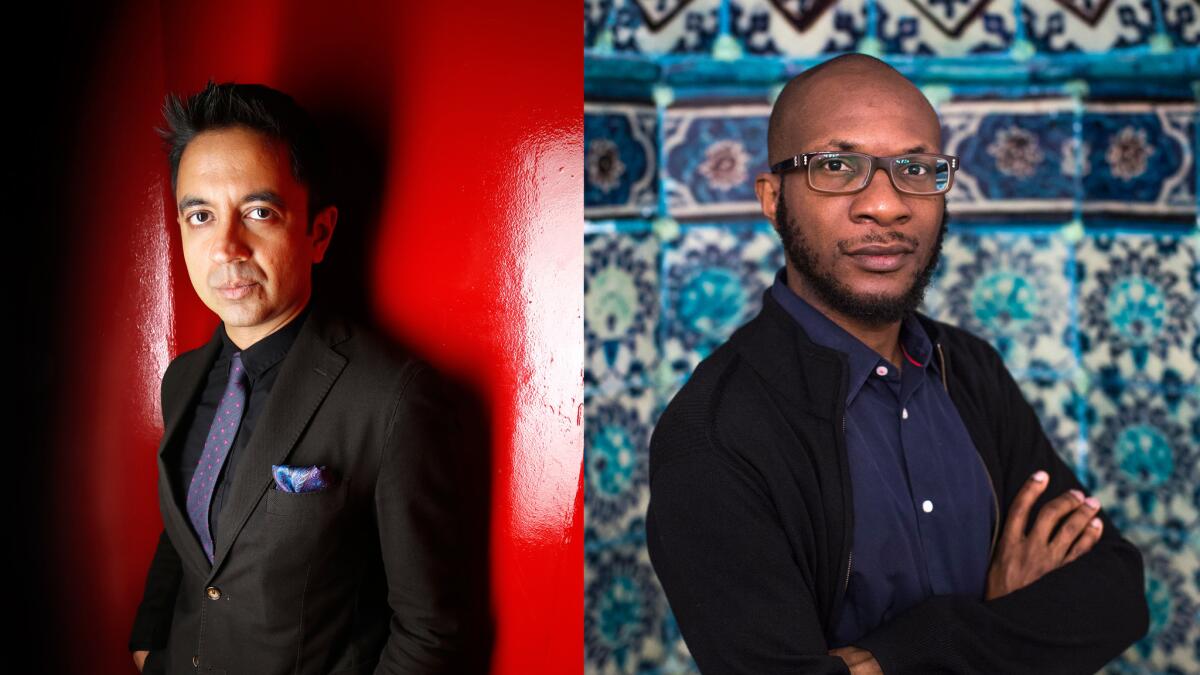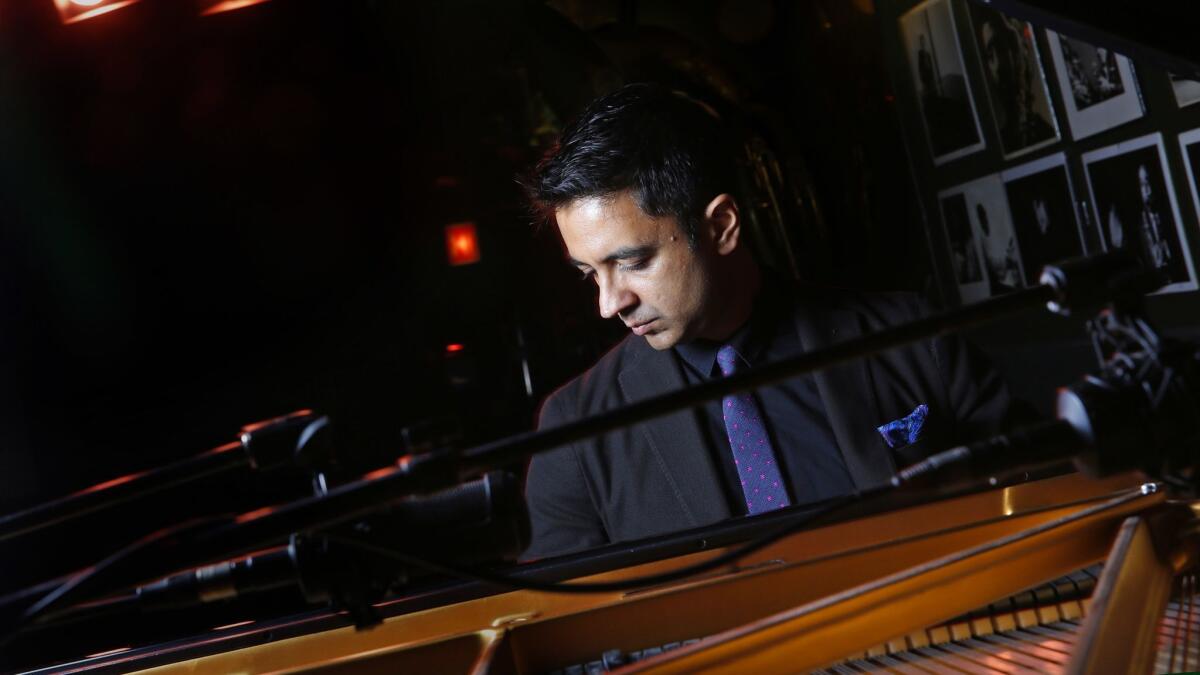Q&A: Teju Cole on turning his photography into music with jazz pianist and fellow polymath Vijay Iyer
Teju Cole sits at the center of a peculiar Venn diagram: He is a novelist who does double duty as a photographer and a photographer who also happens to be a photography critic. (Cole is the writer behind the ruminative “On Photography” column for New York Times Magazine.) In his work, one area of interest frequently seeps into the next.
His debut novel, “Every Day Is for the Thief” (published in Africa in 2007 and in the U.S. in 2014), features his photography of interstitial snippets of urban life in Nigeria, where his family is from. Last year, he published “Blind Spot,” a hybrid book that more formally pairs his photography with diminutive essays — often no more than one, two or three paragraphs long — that function as reflections on topics as diverse as history, forgetting and dreaming.
Now he is teaming up with another polymath: Vijay Iyer, the composer and jazz pianist — who also happens to be a trained physicist — and whose musical work absorbs influences from an array of genres, including hip-hop and south Indian classical music.

On Saturday, the pair will collaborate on an experimental performance inspired by “Blind Spot” that will be presented by UCLA’s Center for the Art of Performance at the Theatre at the Ace Hotel in downtown Los Angeles. Iyer and a band of musicians will improvise a score as Cole delivers his essay fragments as spoken word. Functioning as visual backdrop will be the author’s images: Photos that might seem banal — a set of closet doors or a stretch of blue tarp — but which, upon further scrutiny, often reveal surprising layers.
Cole says that he and Iyer have performed the work on several occasions and “it’s different every time.”
“It’s a high-wire act,” he adds. “It doesn’t have a set text.”
In this edited conversation, Cole, who is based in New York, chats about stalking jazz musicians, how it’s possible to create a musical score out of pictures, and why he could always, always use another camera.
You first worked with Iyer on a performance tied to your 2011 novel “Open City.” How did you two come to work together?
I know the first time I heard of him: It was the year 2000 and I was reading Time Out New York and it says this dude trained as a physicist and he’s now a pianist. In the years that followed I started to go to his concerts. If you show up enough at somebody’s concerts, they’re like, “There’s that dude.” Jazz fans can be a bit scary. They will stalk you!
When I published my first book, “Every Day Is for the Thief,” I mentioned him in passing. I gave him a copy of that book. Then “Open City” came out and he read that, and a year or so after, he asked if he could use it and I wanted to be involved. So we did “Open City” at Montclair State University [in New Jersey] with this beautiful big band. Everyone in that band was a leader in their own band and the level was ferociously high. It was only two performances, but that was the genesis.
I tell Vijay that we are on peculiarly parallel tracks. We practice very different art forms and our forms of expression are different, but our political views are very similar. We are both extremely hybrid and approach the question of inclusivity in a very complex way. Neither of us has very much time for simplicities.
For “Blind Spot,” Iyer doesn’t work with a set score. Instead, he improvises one based on your text and your images. How does that work?
The question we get often is, “Is this improvised?” I love the answer that Vijay gives to that. He gives a very thoughtful and philosophical answer to what we mean by a score. A score is not just notes walking up and down a Western staff. For him, and in practice for us, the score was the images, the words I’m reading, and the pace at which I move to the next image, our collective presence and those of us on the stage and those of us in the audience. So if you zoom out and you say that the score is what you’re reading, rather than what you play, there is a score.

When did you first pick up a camera? And how does it intersect with your writing?
My writing and my photography started — in terms of level of focus, seriousness and confidence — these two things started at the same time. I was training my eye.
In 2004, I started photographing in earnest. Since that time, I’ve done both very seriously. It’s just that the writerly aspect came out into the world first. That’s why “Blind Spot” feels like a culmination. For me, those pictures have the same maturity as my writing.
I’m a photography critic, so it’s thinking not just how to write about pictures, but how to talk about what a photographer is doing. It’s not possible to separate the eye with which I look at someone’s photography from the eye with which I look through the viewfinder. Photography is photography criticism. Writing is literary criticism. My writing is full of the reading I’ve done and my photography is full of the photography I’ve seen — combined with my own experience.
Are you a film guy? Or do you prefer digital?
I’ve done both. I have the problem that every photographer has, which is, I have too much gear. I have nine cameras — four are film, five are digital. There is nothing I need so urgently right now like a 10th. You always think your next camera is going to be the access to a new way of seeing.
Sometimes I use [my phone] as notation. I’m very open. People always ask, “What’s the best camera to use?” My answer is, “The one that is with you.”
You often capture images of images: the reflection of sky on glass or palm trees rendered on a man’s shirt. Why do these intrigue you?
I think they are discursive moments. Life is reflecting on itself — no pun. If the camera is what I’m approaching with, it cannot pretend to be the only camera in the world and I cannot pretend to be the only image maker in the world. But I don’t know what the attraction is. It has, in part, to do with being a writer. These are very much the pictures of a writer. They are think-y and a bit ironic. They’re just a little bit unstable and sly.
The idea of the quiet revelation brings us to what the title of the book is. The book is called “Blind Spot.” I had eye trouble. I temporarily went blind in my left eye. It was only for a few days. In the years that followed, my photography got quieter and more attentive. I came to care more for the everyday miracle, the miracle that is so soft it barely counts as a miracle at all — to be standing in a landscape and the wind suddenly lifts up a net. It is the most ordinary thing and it takes my breath away.
What’s the process of putting text and image together? Do you shoot first, then write? Or vice versa?
I take notes at the time of being in places. I take a lot of photographs. You never know until you develop your film whether that idea worked. If I photograph a shining Mediterranean full of boats, it could be a perfectly banal picture or it could work. It might just have enough tension in it. I don’t know for weeks and months after I develop the film whether something I’ve done retains its charge. And I don’t know of the many things I’ve jotted down which one is worth writing up more fully. It’s not about text or image coming first. It’s about being attentive — about having both pieces come together like magnets.
You have shown your photos in books, galleries and Instagram. How does including them in a musical performance shape what you present?
I think there is the larger theoretical work. That would be 10,000 images and it looks like an obsession unfolding. The book is a quintessence of a certain tendency inside of the work. The archive isn’t deep enough for another book of this quality. But it is deep enough for another 30 images that tell another story. For the exhibition, which is 33 images, I have to pick it mostly based on what looks good printed large. Meanwhile, for the stage performance, which is 25 to 30 images, the stronger criterion is what sounds good spoken out loud, what creates a cloud of oral meaning. That becomes the strongest criterion — it becomes about indeed creating a good score for the musicians.
Vijay Iyer and Teju Cole: “Blind Spot”
Where: The Theatre at Ace Hotel, 929 S. Broadway, downtown Los Angeles
When: Sept. 22 at 8 p.m.
Tickets: $26-$60
Info: cap.ucla.edu and theatre.acehotel.com
ALSO
Teju Cole uses his camera and his writing to pry open the cities he visits in ‘Blind Spot’
Going back to Lagos in Teju Cole’s ‘Every Day Is for the Thief’
Ojai Music Festival expands its eclectic vision under the eye of Vijay Iyer
Vijay Iyer jazzes up the Ojai Music Festival
Sign up for our weekly Essential Arts & Culture newsletter »
[email protected] | Twitter: @cmonstah
More to Read
The biggest entertainment stories
Get our big stories about Hollywood, film, television, music, arts, culture and more right in your inbox as soon as they publish.
You may occasionally receive promotional content from the Los Angeles Times.











